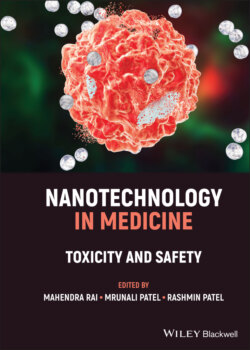Читать книгу Nanotechnology in Medicine - Группа авторов - Страница 34
На сайте Литреса книга снята с продажи.
3.1 Introduction
ОглавлениеToday, nanotechnology affects almost all areas of activity, including medicine. NPs are unique, biologically active objects because of their small size, relatively large area, surface modification, as well as presence of surface charges, better solubility, and multifunctionality. Their use allows us to solve many biopharmaceutical and pharmacokinetic problems. NPs often increase the therapeutic efficacy of drugs and improve the solubility of compounds in water. Also, the features of NPs allow them to be used for targeted drug delivery (Chaudhary et al. 2014; Chenthamara et al. 2019; Khan et al. 2020; Shurygina and Shurygin 2020). NPs have unique properties that are not characteristic of substances included in them in a different state (Fadeeva et al. 2015; Shurygina et al. 2016).
A special place among nanotechnologies is occupied by nanocomposites containing essential substances that are part of the mammalian enzyme systems. Often, there is a shortage of these microelements in the environment. An important role among them belongs to Se. This is an essential biologically active microelement and is part of selenoproteins (Khurana et al. 2019). So, as selenocysteine, Se is a part of antioxidant enzymes such as glutadione peroxidase, thioredoxy reductase, and selenoprotein P. In these enzymes, Se acts as a redox center and is necessary to maintain the biochemical activity of the enzymes. Se is also involved in the maintenance of redox homeostasis, inflammatory and immunological reactions by regulating the expression of inflammatory genes at the epigenetic level (Broome et al. 2004). Also, it participates in carbohydrate metabolism, shows a high reactivity to oxidizing agents (Sharifi et al. 2012; Casaril et al. 2017). Se, as a component of enzymes, affects reproductive health and the maintenance of brain function in Alzheimer's disease (Jin et al. 2017). Elemental Se in nanoform has neuroprotective properties (Amani et al. 2019), antitumor activity where SeNPs act as an apoptosis inducer of cancer cells (Sukhov et al. 2017; Trukhan et al. 2018; Xu et al. 2020), and is a highly effective prolonged‐action antioxidant in regenerative medicine (Shurygina and Shurygin 2017, 2018; Tan et al. 2019; Qiao et al. 2020; Bai et al. 2020a).
Se deficiency is associated with numerous human diseases (Vinceti et al. 2017). At the same time, an excess of Se can be toxic and lead to selenosis. Over the past decades, many researchers have identified the significant biomedical potential of SeNPs. However, along with favorable results, it is very important to study the negative and possible side effects associated with the use of Se in nanoforms. NPs are able to enter into the human body by inhalation, oral, parenteral routes and interact with intracellular structures and macromolecules for a long time. Entered NPs can be distributed to various organs, where they are able to retain their structure or to be modified, metabolized.
Unfortunately, today there is no unambiguous information on whether NРs are absolutely safe for humans or have a certain toxicity. Thus, the study of the absorption, distribution, metabolism, and excretion of NPs also as the mechanisms of interaction with living systems studies are necessary to understand their activity, behavior in biological systems, and potential in vivo hazards.
